




Ceramic sinks are a popular choice for many homeowners due to their durability and timeless aesthetic appeal. However, over time, these sinks can become stained and dirty, diminishing their beauty. Cleaning a ceramic sink may seem like a daunting task, but with the right techniques and products, you can restore its shine and keep it looking brand new.
Step 1: Gather Your Supplies
Before you begin cleaning your ceramic sink, gather all the necessary supplies. This includes a non-abrasive cleaner, such as a mild dish soap or a commercial ceramic sink cleaner, a soft sponge or cloth, a toothbrush or soft-bristle brush for scrubbing, and a microfiber towel for drying.
Step 2: Prep the Sink
Start by removing any large debris or food particles from the sink. Then, rinse the sink with warm water to remove any loose dirt or grime. This will make the cleaning process more effective.
Step 3: Apply the Cleaner
Pour a small amount of the non-abrasive cleaner onto a sponge or cloth. Gently scrub the entire surface of the sink, paying extra attention to any stained or discolored areas. Avoid using harsh scrubbing brushes or abrasive cleaners, as they can scratch the surface of the sink.
Step 4: Time for Some Elbow Grease
If you encounter any stubborn stains or buildup, use a toothbrush or soft-bristle brush to scrub the area. Apply a bit more pressure, but be careful not to damage the sink. For tougher stains, you can create a paste using baking soda and water and apply it to the affected area. Let it sit for a few minutes before scrubbing.
Step 5: Rinse and Dry
Once you have thoroughly cleaned the sink, rinse it with warm water to remove any residue from the cleaner. Use a microfiber towel to dry the sink, ensuring there are no water spots or streaks left behind.
Expert Tip: To maintain the cleanliness of your ceramic sink, wipe it down regularly with a soft cloth or sponge and a mild cleaner. This will help prevent the buildup of dirt and stains.
By following these step-by-step instructions and expert tips, you can keep your ceramic sink looking spotless and beautiful for years to come. Regular cleaning and maintenance will not only enhance the longevity of your sink but also create a pleasant and hygienic environment in your kitchen or bathroom.
Step-by-Step Guide on How to Clean a Ceramic Sink
Gather Your Supplies
Before you start cleaning your ceramic sink, make sure you have all the necessary supplies on hand. Here’s what you’ll need:
- Gloves
- All-purpose cleaner or mild dish soap
- Baking soda
- Vinegar
- Soft sponge or cloth
- Toothbrush
- Old toothbrush or small brush for grout (if applicable)
- Microfiber towel or paper towels
Remove Any Debris
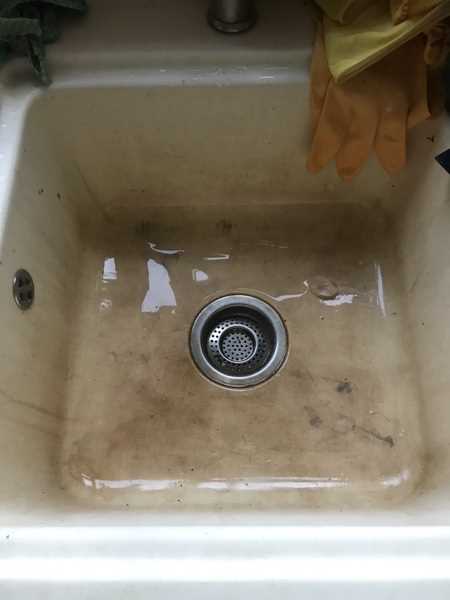
Start by removing any visible debris from your ceramic sink. Use your hands or a paper towel to clear away larger pieces of food or other waste. Dispose of the debris in a trash bin.
Apply All-Purpose Cleaner or Mild Dish Soap
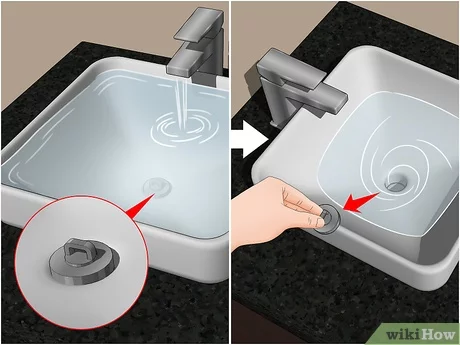
Apply a small amount of all-purpose cleaner or mild dish soap to your soft sponge or cloth. Gently scrub the entire surface of the sink, including the sides and bottom. Pay special attention to any areas with stains or buildup.
Scrub with Baking Soda
If there are stubborn stains or mineral deposits in your sink, sprinkle baking soda over the affected areas. Wet your sponge or cloth and scrub the baking soda into the stains. The abrasive properties of baking soda will help lift away the grime.
Rinse with Vinegar
Once you’ve scrubbed with baking soda, rinse the sink thoroughly with vinegar. Pour vinegar over the entire surface and let it sit for a few minutes to break down any remaining residue.
Remove Grout Stains (if applicable)
If your ceramic sink has grout lines, use an old toothbrush or small brush to scrub away any stains or buildup in the grout. Apply a mixture of baking soda and water to the grout, scrubbing in a circular motion. Rinse with water when finished.
Rinse and Dry
After cleaning your ceramic sink, thoroughly rinse it with warm water to remove any cleaning product residue. Use a microfiber towel or paper towels to dry the sink, paying special attention to any remaining moisture in corners or crevices.
Maintain Your Ceramic Sink
To keep your ceramic sink looking its best, establish a regular cleaning routine. Wipe down the sink daily with a damp cloth or sponge and mild dish soap. Avoid using harsh abrasives or cleaners that could damage the ceramic surface.
Prepare your cleaning materials
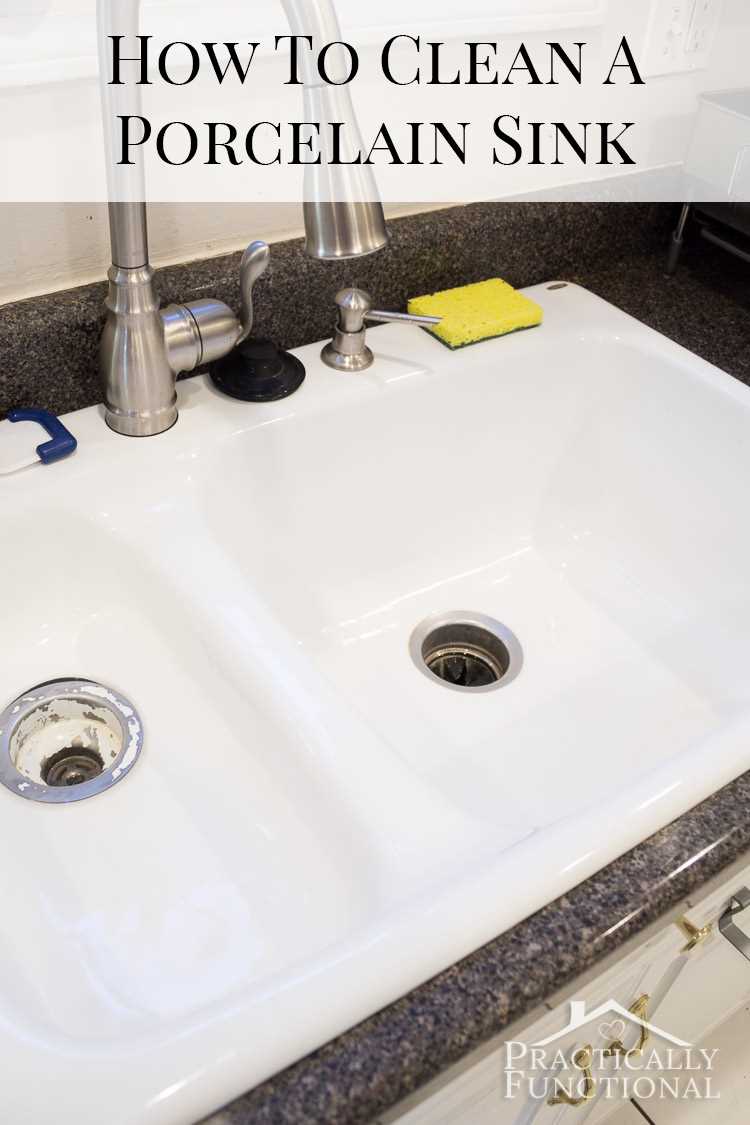
- Gloves – to protect your hands from harsh chemicals
- Vinegar – a natural cleaner that is effective at removing stains
- Baking soda – another natural cleaner that can help with stubborn stains
- Mild dish soap – for general cleaning
- Soft cloth or sponge – to scrub the sink
- Toothbrush – for hard-to-reach areas
- Microfiber cloth – for drying and polishing
- Bucket or basin – for mixing cleaning solutions
- Old toothpaste – can be used as a gentle abrasive
Optional materials
- Hydrogen peroxide – for disinfecting purposes
- White or distilled vinegar – if you don’t have regular vinegar
- Lemon juice – for a fresh scent
- Rubbing alcohol – for sanitizing the sink
Make sure you have all of these materials ready before you start cleaning your ceramic sink. Having everything prepared will make the cleaning process smoother and more efficient.
Remove any debris from the sink
Before starting the cleaning process, it is important to remove any debris or food particles from the sink. This will make the cleaning process easier and more effective.
To remove debris from the sink, follow these steps:
- Start by removing any larger pieces of debris by hand. Use gloves if necessary to protect your hands.
- Next, use a soft sponge or cloth to wipe away any remaining debris. Make sure to reach all corners and edges of the sink.
- If there are any stubborn stains or residue, you can use a mild dish soap and warm water solution to help loosen them. Apply the solution to a sponge or cloth and scrub the affected areas gently.
- Rinse the sink thoroughly with clean water to remove any soap or residue.
- Dry the sink using a clean, dry cloth or towel to prevent water spots.
By removing any debris from the sink before cleaning, you will ensure that the cleaning process is more effective and that your ceramic sink will shine brightly when you are finished.
Apply a cleaning solution to the sink
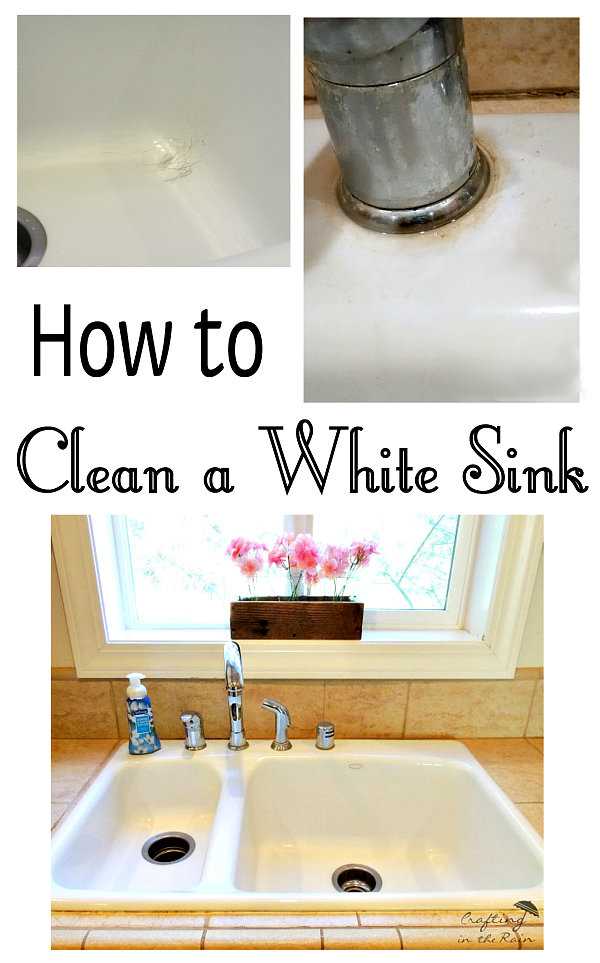
Once you have gathered your cleaning supplies and prepared your sink by removing any debris, it is time to apply a cleaning solution to the surface. There are several options to choose from when selecting a cleaning solution for your ceramic sink.
1. Dish soap and warm water
One simple and effective cleaning solution for ceramic sinks is a mixture of dish soap and warm water. This gentle solution is perfect for everyday cleaning and can easily remove light stains and grime.
To make the cleaning solution, fill a basin or a bucket with warm water and add a few drops of dish soap. Mix well until the soap is fully dissolved.
Once the solution is ready, dip a soft cloth or sponge into the soapy water and begin wiping down the sink. Pay special attention to any areas with stains or build-up, and scrub gently as needed.
Rinse the sink thoroughly with clean water once you have finished cleaning with the soapy solution to remove any residual soap.
2. Baking soda and vinegar
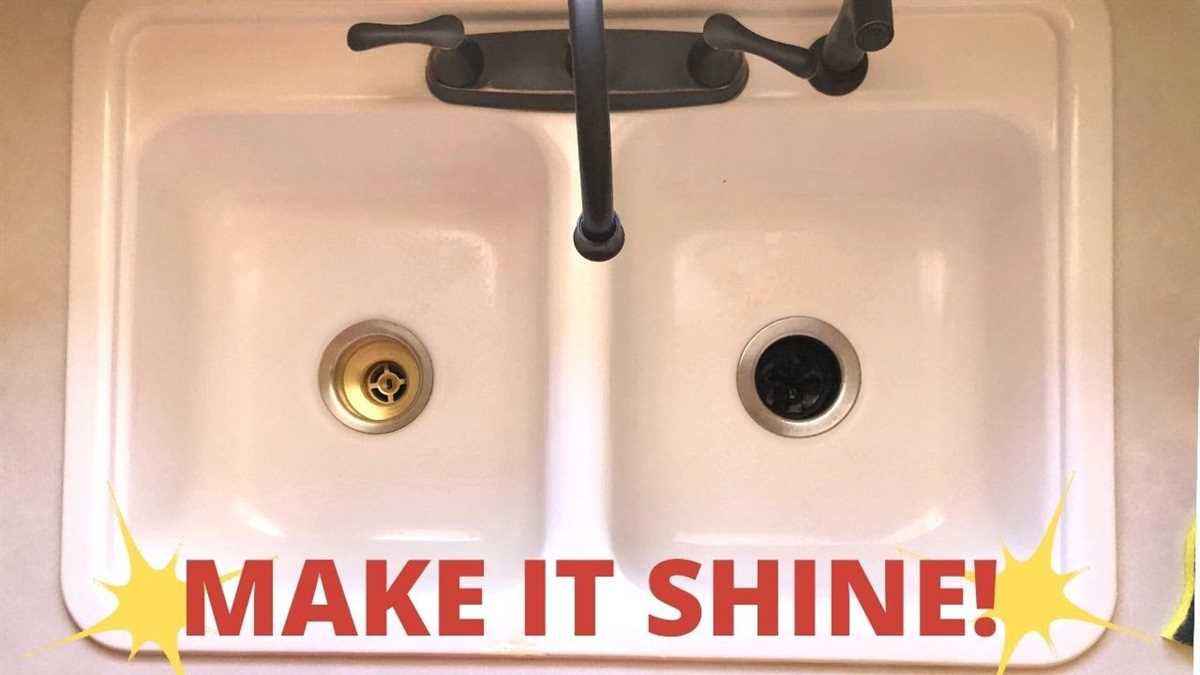
If you need a more powerful cleaning solution for tough stains or mineral deposits, you can use a combination of baking soda and vinegar.
To create the cleaning paste, mix equal parts of baking soda and vinegar in a bowl until it forms a thick paste. Apply the paste to the affected areas and let it sit for about 10 minutes to loosen the stains.
After the paste has had time to work its magic, scrub the sink using a soft scrub brush or sponge. The combination of baking soda and vinegar will help to break down the stains and make them easier to remove.
Once you have finished scrubbing, rinse the sink thoroughly with clean water to remove any residue. Repeat the process if necessary.
3. Commercial ceramic sink cleaner

If you prefer to use a ready-made cleaning solution specifically designed for ceramic sinks, there are many options available on the market. These cleaners are typically formulated to remove tough stains, mineral deposits, and soap scum without damaging the ceramic surface.
Follow the instructions on the product packaging to properly apply the cleaner to your sink. Most commercial cleaners require you to spray or apply the solution to the surface and then scrub with a brush or sponge. Rinse the sink thoroughly with clean water after cleaning to remove any residue.
Regardless of the cleaning solution you choose, always read and follow the manufacturer’s instructions to ensure safe and effective use.
Scrub the sink with a non-abrasive sponge
Now that you have sprayed the sink with a cleaning solution and let it sit for a few minutes, it’s time to start scrubbing. Grab a non-abrasive sponge or scrub brush that is safe for use on ceramic surfaces. It’s important to avoid using abrasive materials like steel wool or scouring pads, as these can scratch the sink’s surface.
Start by wetting the sponge or brush with water, then apply a small amount of dish soap or a mild cleaning solution to it. Work the soap into a lather before scrubbing the sink.
Using gentle yet firm pressure, scrub the sink in circular motions, paying extra attention to any stained or dirty areas. The non-abrasive sponge or brush should effectively remove any dirt, grime, or stains without damaging the ceramic surface.
Continue scrubbing until the entire sink is clean and free of any residue. Rinse the sponge or brush regularly to remove any buildup and ensure an effective cleaning process.
Once you have scrubbed the sink thoroughly, rinse it with clean water to remove any remaining soap or cleaning solution. Use a clean cloth or towel to dry the sink and remove any excess moisture.
Remember, it’s always best to consult the manufacturer’s guidelines for specific cleaning recommendations for your ceramic sink. If in doubt, test any new cleaning products on a small, inconspicuous area of the sink first to ensure they do not cause any damage.
Rinse and dry the sink
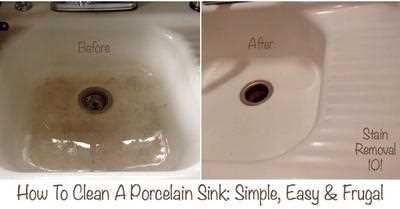
Once you have scrubbed the sink with a cleaning solution and scrub brush, it’s time to rinse away any residue. You can use a handheld sprayer or fill a bucket with water to rinse the sink thoroughly. Make sure to rinse all surfaces, including the faucet and drain.
After rinsing, use a clean cloth or towel to dry the sink. This helps prevent water spots and keeps the sink looking clean and shiny. Pay special attention to the faucet and any chrome or stainless steel fixtures, as these can show water spots more easily.
If you prefer, you can also use a microfiber cloth or paper towels to dry the sink. Microfiber cloths are absorbent and gentle on the surface of the sink, making them a good option for drying.
Once the sink is dry, take a step back and admire your sparkling clean ceramic sink!
Expert Tips

- Use gentle cleaning products: When cleaning a ceramic sink, it’s important to use gentle cleaning products that won’t damage the surface. Avoid using abrasive cleaners or scrub brushes, as they can scratch the sink. Instead, opt for mild dish soap or a specialized ceramic sink cleaner.
- Wipe the sink regularly: To keep your ceramic sink clean and free from stains or residue, it’s a good idea to wipe it down regularly with a soft cloth or sponge. This will help prevent build-up and make cleaning easier in the long run.
- Don’t let water sit for too long: After using your ceramic sink, be sure to dry it with a towel or cloth. Allowing water to sit in the sink for extended periods can lead to staining or discoloration. If you notice any water spots or stains, try buffing them out with a mixture of baking soda and water.
- Avoid using harsh chemicals: Harsh chemicals like bleach or ammonia can damage the surface of a ceramic sink. It’s best to avoid using them altogether. If you need something more powerful to remove stubborn stains, try using a mixture of vinegar and water instead.
- Protect the sink from heavy objects: Ceramic sinks can chip or crack if heavy objects are dropped into them. To prevent any damage, be mindful of what you place in the sink and try to avoid dropping anything heavy. If you do accidentally chip or crack your sink, it’s best to contact a professional for repairs.
- Regularly clean the drain: To keep your ceramic sink in top condition, don’t forget to clean the drain. Use a drain cleaner or a mixture of baking soda and vinegar to remove any build-up or odors. It’s a good idea to do this at least once a month.
FAQ
What are some common household items that can be used to clean a ceramic sink?
There are several common household items that can be used to clean a ceramic sink. Some examples include baking soda, vinegar, lemon juice, and dish soap.
Is it safe to use bleach to clean a ceramic sink?
While bleach can be effective at removing stains from a ceramic sink, it is important to use it with caution. Bleach is a strong chemical and can cause damage to the sink if not used properly. It is recommended to dilute the bleach with water and to avoid prolonged exposure.
What is the best way to remove hard water stains from a ceramic sink?
One of the most effective ways to remove hard water stains from a ceramic sink is to use a mixture of vinegar and water. Simply apply the mixture to the stained areas, let it sit for a few minutes, and then scrub with a non-abrasive sponge or cloth.
How often should I clean my ceramic sink?
It is recommended to clean a ceramic sink at least once a week to prevent the buildup of dirt and grime. However, if you use the sink frequently or notice any stains or buildup, it may be necessary to clean it more often.











